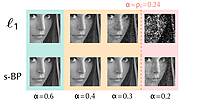Abstract
Compressed sensing has triggered a major evolution in signal acquisition. It consists of sampling a sparse signal at low rate and later using computational power for the exact reconstruction of the signal, so that only the necessary information is measured. Current reconstruction techniques are limited, however, to acquisition rates larger than the true density of the signal. We design a new procedure that is able to reconstruct the signal exactly with a number of measurements that approaches the theoretical limit, i.e., the number of nonzero components of the signal, in the limit of large systems. The design is based on the joint use of three essential ingredients: a probabilistic approach to signal reconstruction, a message-passing algorithm adapted from belief propagation, and a careful design of the measurement matrix inspired by the theory of crystal nucleation. The performance of this new algorithm is analyzed by statistical-physics methods. The obtained improvement is confirmed by numerical studies of several cases.
1 More- Received 1 December 2011
DOI:https://doi.org/10.1103/PhysRevX.2.021005
This article is available under the terms of the Creative Commons Attribution 3.0 License. Further distribution of this work must maintain attribution to the author(s) and the published article’s title, journal citation, and DOI.
Published by the American Physical Society
Popular Summary
When you want an image with -pixel resolution, how many imaging data points do you need? , the obvious answer seems to be. No, says compressed sensing, a branch of signal-processing science and computational statistics. This research branch develops methods of acquiring and reconstructing a signal that rely on fewer data-acquisition points or measurements than what was previously considered possible, and has enabled faster and more precise measurements in a wide range of applications, including cameras, computed tomography, magnetic-resonance imaging, and genome sequencing. Current techniques are, however, still not optimal, requiring more data points or measurements than necessary. In this interdisciplinary paper, we have designed and tested a new compressed-sensing strategy that allows us to go significantly beyond the known limits for data acquisition and signal reconstruction, by bringing methods and inspirations from statistical physics to bear on compressed sensing—a field that traditionally does not belong to physics.
Mathematically, the problem of compressed sensing is easy to formulate. The signal to be reconstructed is an -component one, represented by a vector ( can be viewed as the total number of pixels desired), and compressed sensing deals with signals that are “sparse,” with only a fraction () of the components being nonzero. The actual acquired data is represented by an -component vector, , with also being only a fraction of . and are connected linearly by a known mapping. Reconstruction of signal then becomes a problem of performing the inverse mapping. Current strategies use linear-programming-based optimization to determine the right inverse mapping. But, they require more data points than would be absolutely necessary, i.e., must be larger than .
The strategy we have designed, called the seeded belief-propagation algorithm, approaches the signal acquisition and reconstruction in a radically different way. It views the ultimate signal to be reconstructed as the result of a sufficient sampling of a probabilistic Boltzmann-measure-like distribution, which depends on the mapping that corresponds to data-acquisition measurements and the acquired data points. Using a class of specially designed mappings that exploit the physics intuition about crystal nucleation and a sampling technique known to statistical physics as the belief-propagation algorithm, our new compressed-sensing protocols achieve, in a computationally efficient manner, exact reconstruction of the original signal, not only when is larger than , but also as approaches , in other words, as the number of acquired data points approaches the absolute minimum. In fact, the examples we have tested show that the gains are stunning.
We would like to think that our interdisciplinary approach breaks new ground in the field of compressed sensing, and we anticipate many further fundamental developments and practical applications.



